#Pratchat87 Notes and Errata
These are the episode notes and errata for Pratchat episode 87, “Exclusive Possession: Ankh-Morpork Edition”, discussing Martin Wallace’s 2011 Discworld board game, Discworld: Ankh-Morpork, with guest Richard McKenzie.
Iconographic Evidence
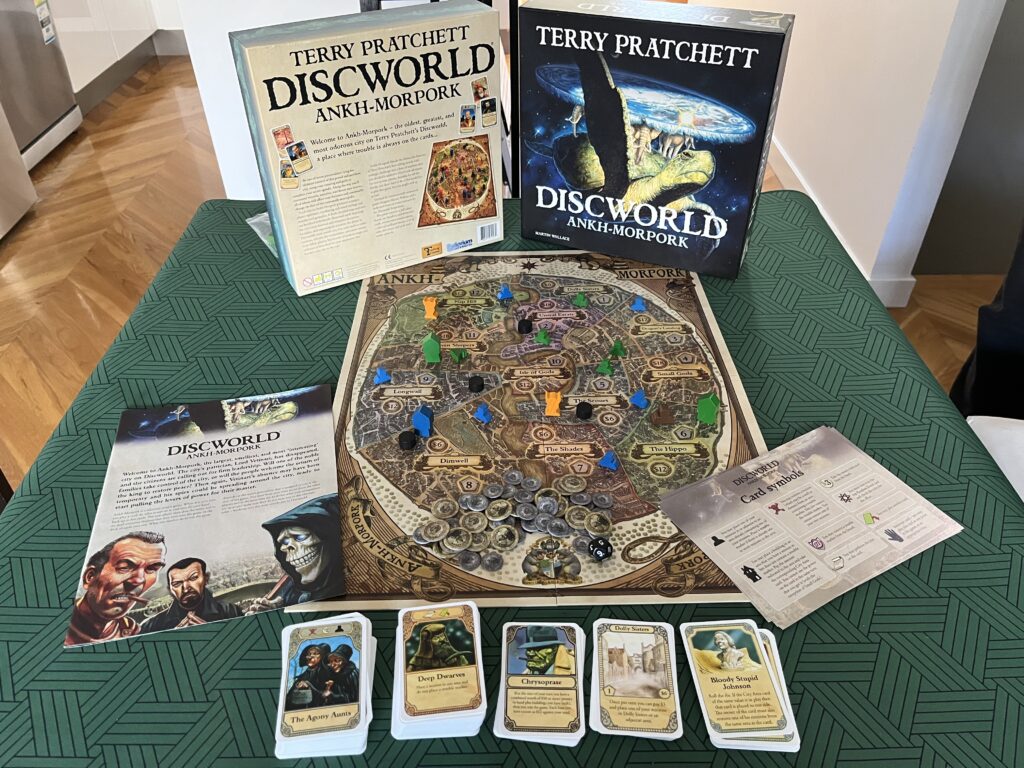
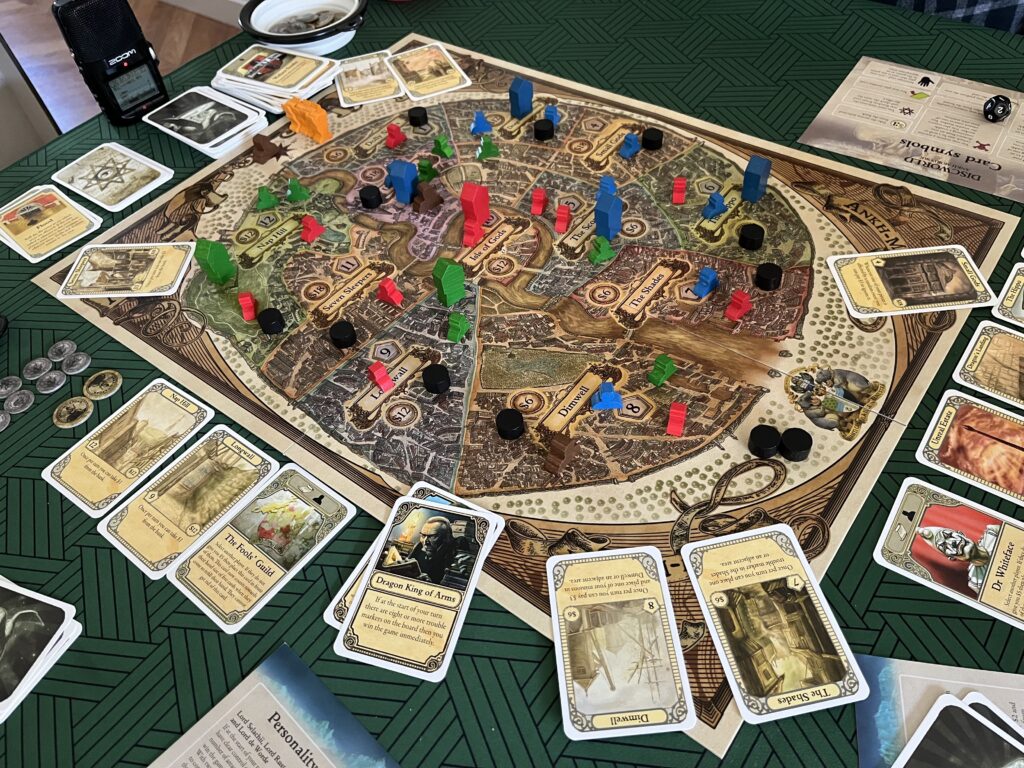
Below are all the specific cards we mentioned this episode; you can also find lots more photos of the game on its BoardGameGeek page.
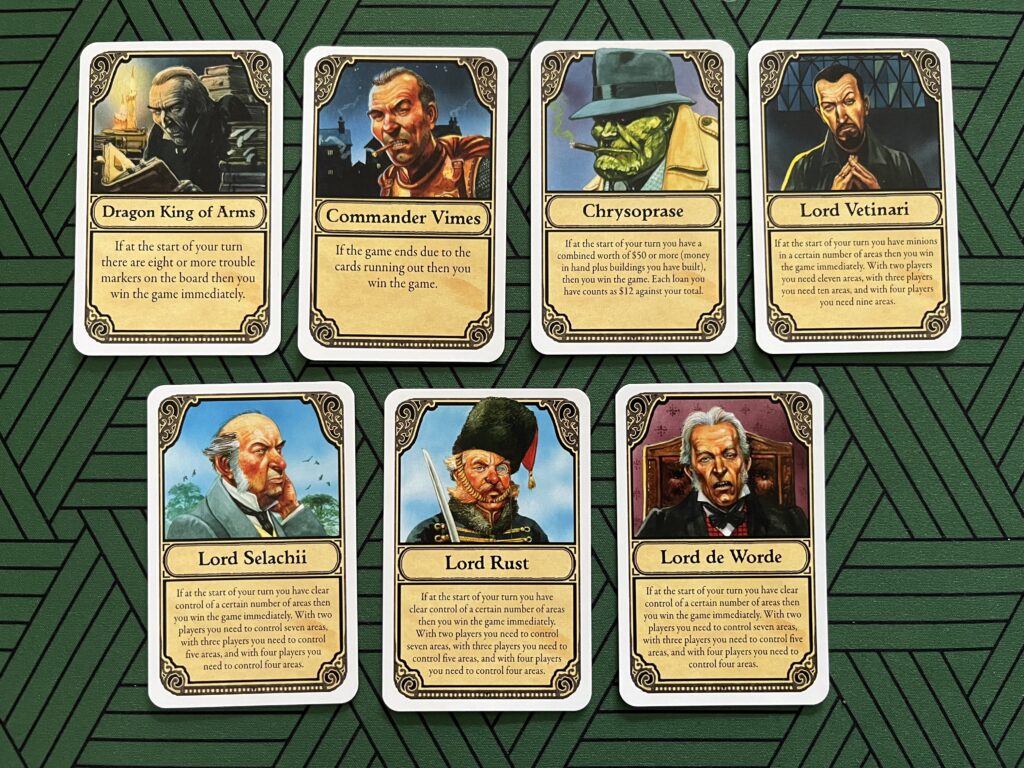
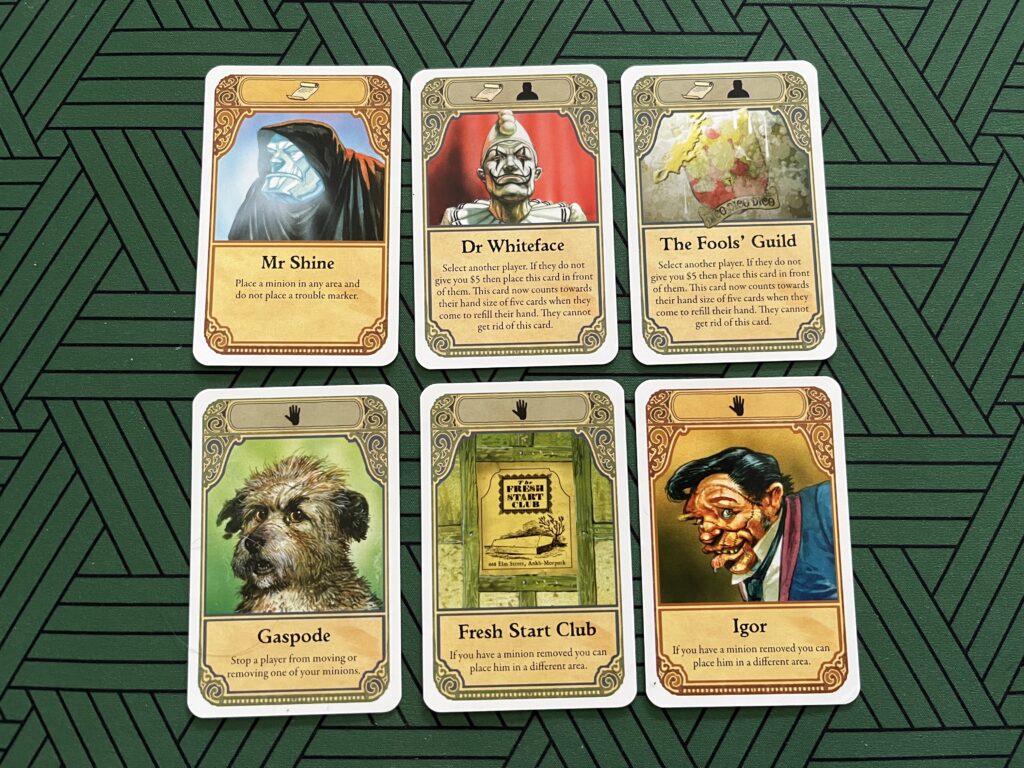
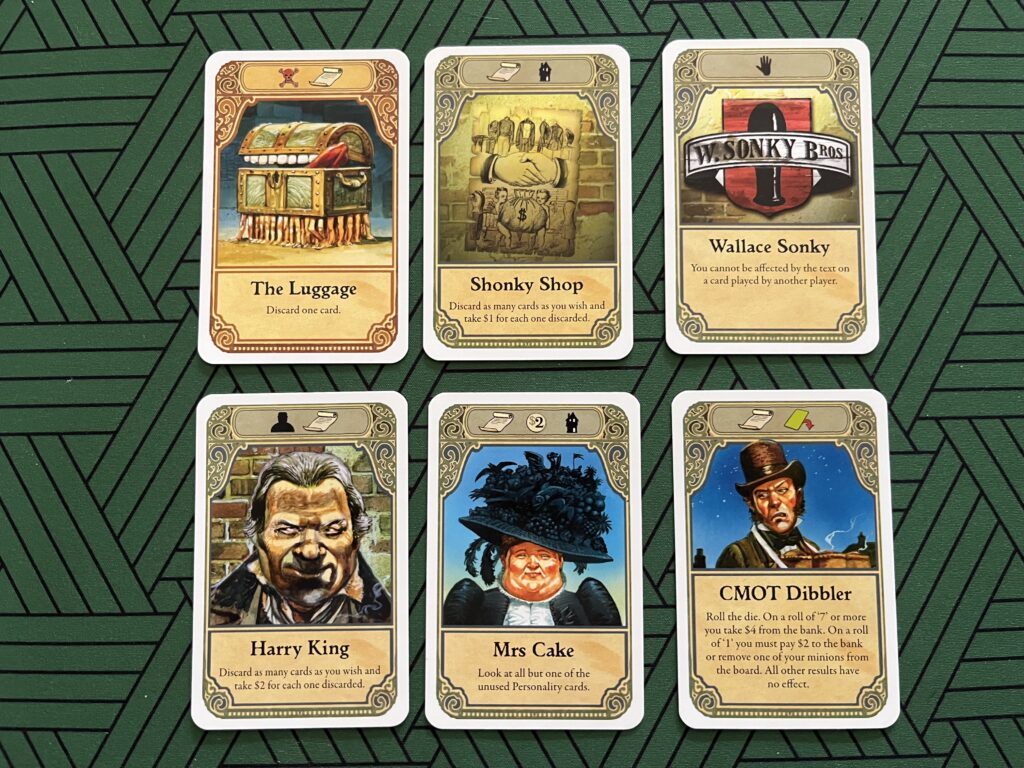
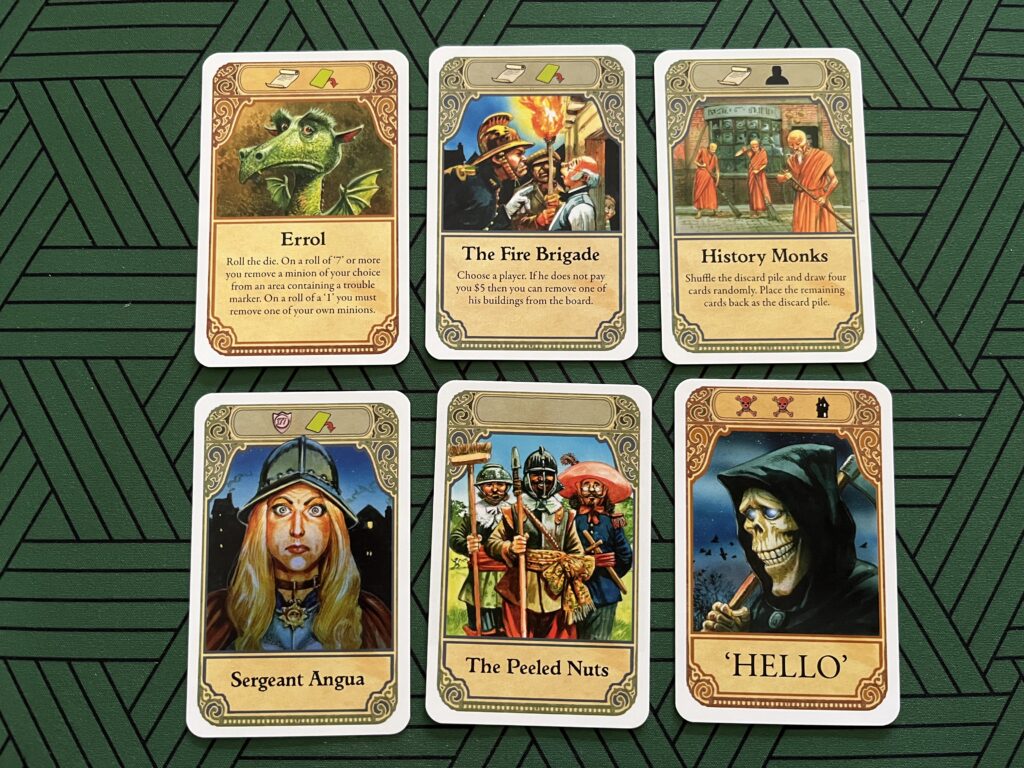
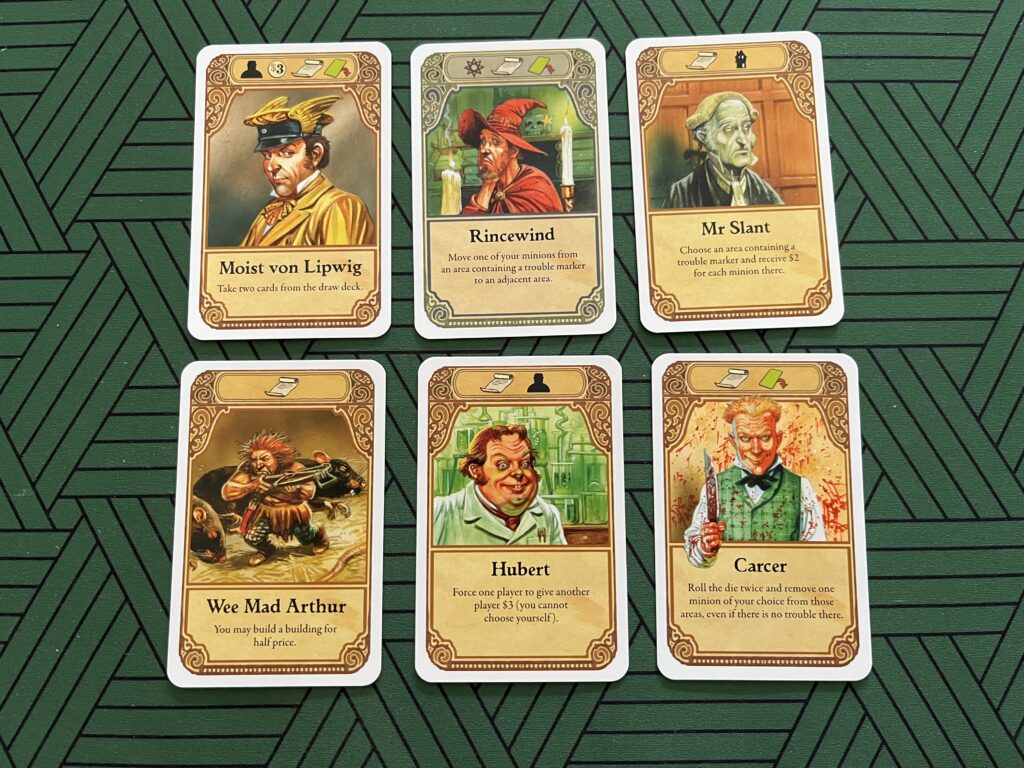
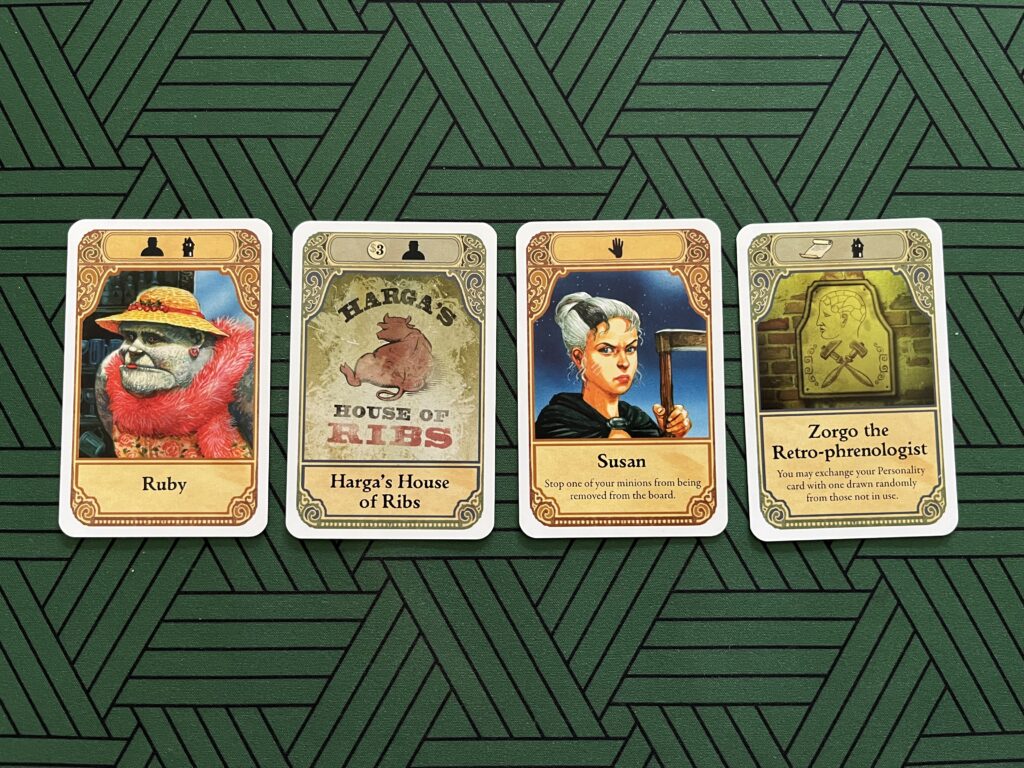
Notes and Errata
- The episode title refers to Exclusive Possession the suspiciously Monopoly-like game to which a dying person once challenged Death. Death briefly mentions this in Reaper Man. (He was the boot.)
- Richard previously appeared on #Pratchat5, “Ten Points to Viper House” discussing Pyramids, and #Pratchat40, “The King and the Hole of the King”, discussing The Fifth Elephant.
- We mention a lot of board games in this episode; some we have more to say about below, but here are most of them in a handy list with BoardGameGeek links and a brief description:
- Ticket to Ride (2004, designed by Alan R. Moon) – a popular gateway game still going strong after all these years. Players take turns to collect sets of coloured cards and play them to place trains on a map of the US (or various other countries in other editions), trying to complete routes between specific cities for points. It’s easy to learn and plays pretty fast, but if you’ve played a few board games already, you might like to consider some of the alternatives in this video from No Pun Included.
- Gloom (2005, designed by Keith Baker) – a storytelling card game in which you try to have the most miserable life in a very miserable family. It’s fun schtick is that the cards are transparent, and you layer them on top of each other. There’s also a Cthulhu version, and a handful of others, including one based on Game of Thrones.
- Big Trouble in Little China: The Game (2018, designed by Christopher Batarlis, Boris Polonsky and Jim Samartino) – a miniatures-based game, adapted from John Carpenter’s 1986 action-comedy movie starring Kurt Russell, Kim Cattrall and James Hong. Up to four players take on the roles of characters from the film to collaboratively defeat the sorcerer Lo Pan, who is trying to lift a curse so he can return to his evil ways. We think Richard might have found an actual playthrough video, though; this how to play video is only 12 minutes long!
- Magic: The Gathering (1993, designed by Richard Garfield) – the first and still the most successful collectible card game, or trading card game. Buy packs of random cards and build a deck consisting of lands which give you points of “mana” in one of five colours, and spells that spend that mana to summon creatures and otherwise attack your opponent.
- Talisman (1983, designed by Robert Harris) – originally published by Games Workshop, this game sort of resembles fantasy Monopoly. Players roll dice to move one of many different characters around a board to land on spaces where something good or bad might happen to them as they seek the “Crown of Command” to win the game. There are several “levels” to move through, and as Richard mentions, lots of expansions which add even more.
- Blood on the Clocktower (2022, designed by Steven Medway) – a modern social deduction game – essentially a much more sophisticated version of Werewolf. Players live in a village struck down by a curse of some kind; everyone has a unique role, and tries to figure out which of them is possessed by a murderous demon – or conceal the demon, to further their own evil plans. The game comes with multiple scenarios and a large number of unique roles, and players are able to continue influencing the game even if their character is killed.
- Pandemic (2008) – we mention this every board game episode, because it’s one of Ben’s favourites. Collaboratively try to collect samples to cure four rampant diseases before they overwhelm the world. The game’s mechanisms have been adapted to everything from Cthulhu to World of Warcraft, Star Wars, Ancient Rome and most recently Lord of the Rings. Designed by Matt Leacock, whose other similar games include Thunderbirds, the Forbidden series, and the “solve climate change” game, Daybreak, co-designed with Matteo Menapace.
- Mythos (1996, designed by Charlie Krank) – another collectible card game from the 1990s, Mythos was a Cthulhu-themed game in which you scored points by telling stories about your investigator’s adventures. Ben still has a bunch of cards and is hoping to play it again soon.
- Oath (2021, designed by Cole Wehrle) – beautiful and colourful, Oath is more or less a wargame about the fight over the throne in a fantasy kingdom. It’s often bigged up for creating interesting stories, but Ben has found it wanting in that department. He’s willing to give it another go, though – not least because it was very expensive. The Discworld fan conversion Ben mentioned is by BGG user dugbride, and basically transforms every card in the game into a Discworld equivalent. Heads up that it uses entirely AI-generated art.
- Cluedo (1949) – an old-school deduction game in which players move around a map of a mansion gathering cards representing clues to a murder. By slowly figuring out which person, weapon and location are missing from the deck, they race to be the first to put the solution together. The original American name is Clue, but the name more familiar to the rest of the world is a pun on “clue” and “Ludo”. Like Monopoly, it’s been released in many themed versions, though it’s usually modified a little more than Monopoly. A lot of the themes have been TV shows, like Brooklyn-99, Miss Fisher’s Murder Mysteries, Doctor Who and Bob’s Burgers. (In more family friendly versions, the crime is no longer a murder.)
- The board game video by Aunty Donna is “Explaining a Board Game” from April 2020.
- There are three editions of Discworld: Ankh-Morpork, and you can find photos of all three on BoardGameGeek:
- The standard edition, the one Ben owns and the one you’ll most likely find secondhand, comes in a standard square-shaped box the same size as Ticket to Ride. It has a painting of Great A’Tuin on the cover (which we think is the art by Paul Kidby). This has the regular wooden pieces seen in our photos, with cardboard coins. It was published by Treefrog Games and Esdevium in the UK, Mayfair Games in the US, KOSMOS in Germany, Phalanx Games in Poland, and a few others in other European countries.
- The Collector’s Edition comes in a rectangular box with alternate art of a dragon flying over Ankh-Morpork by the game’s main artist Peter Dennis. This version includes wooden coins, a custom d12 with “no eight”, a larger board, and a poster of Peter Dennis’ card designs.
- The Deluxe Edition is the same as the Collector’s Edition except that it replaces the minions, buildings, trolls and demons with resin miniatures. Ben particularly likes the demons in this version, which better match the Things from the Dungeon Dimensions in the books than the wooden horned demon tokens.
- The Ankh-Morpork map on the board is more or less based on The Streets of Ankh-Morpork by Steven Player, and so lines up pretty well with that version of the city. The more recent Compleat Ankh-Morpork is more detailed and tweaks a few things.
- The part of the kidney that Liz thought Ankh-Morpork resembled is the glomerulus.
- Nanty Narking (2019) is the “re-implementation” of Discworld: Ankh-Morpork plublished by PHALANX. Re-implementation is board game jargon for re-using the same (or significantly similar) rules with a new theme or narrative – in this case, fictional Victorian London. As Ben mentions in the footnote, the main rules changes are a tweak to the Chrysoprase personality card, and some alternate rules for more advanced play. That includes the alternate personalities Ben mentioned – and you can find Ankh-Morpork versions of those on BoardGameGeek – but also an “Agent & Buildings” variant which introduces two additional sets of cards. Players are dealt three Agent cards and one Building card at the start of the game; these are initially hidden, and provide specific additional powers which interact with the player’s Agents (equivalent to Ankh-Morpork’s Minions) or Buildings on the board.
More notes coming soon!
Thanks for reading our notes! If we missed anything, or you have questions, please let us know.
